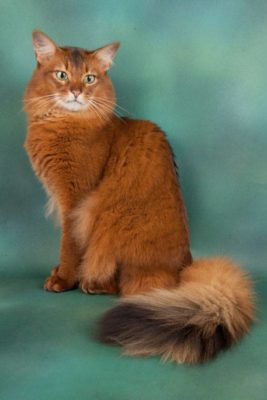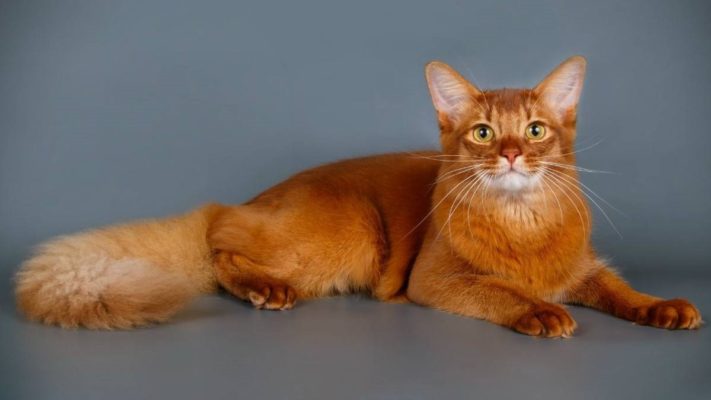Somali
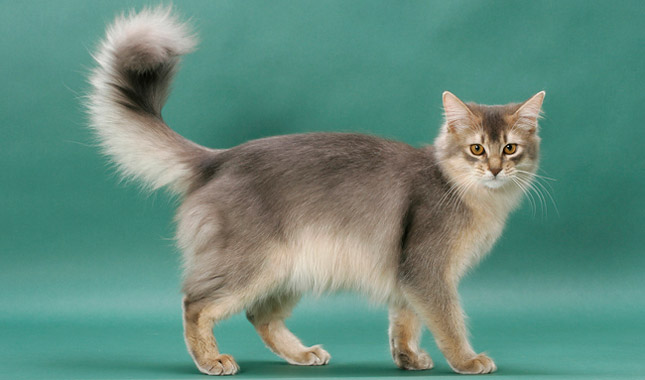
Agile and athletic, these inquisitive cats are known for their agility and playfulness. The Somali makes an excellent pet. Somali cats are very active, so it is not recommended to raise the elderly or sick people who will not look after such a vigorous pet. These cats are a pleasure to look at; they can be admired for hours.
Table of Contents
Breed Information
| Origin | United States |
| Size | Males 26-30 cm Females 22-26 cm |
| Weight | Males 4-5 kg Females 2.5-4 kg |
| Fur Type | Semi-long-haired |
| Color | Sorrel, blue, brown-red, matte cream |
| Lifestyle | Outdoors, indoors |
| Lifespan | 15-20 years |
| FIFe Classification | Classification Category III: “Short-haired and Somali” Breed designation – SOM |
| WCF Classification | Group 2: “Semi-long-haired” Breed designation – SOM |
| TICA Classification | SO |
| Group | Long-haired cats |
| Price | $1000-1500 |
Breed Photos
Origin History
If you’ve never seen a Somali cat, you’ll think it’s a little fox! Although it is a breed of Somali – a graceful cat nicknamed “foxy”. The ancestors of Somali cats remain a mystery. This breed first appeared in America in 1950. It is believed that the Somali was bred by crossing Abyssinian with other long-haired cats. It resulted in a peculiar long-haired Abyssinian. Officially, the breed of Somali cats was recognized in 1978.
The Somali cat name was invented by the American breeder Evelyn Mague. She decided to name the cat’s new breed after the country closest to Abyssinia (now Ethiopia). It turned out to be the African country of Somalia. These states have much in common; they are separated only by a conventional border on the map, like the Abyssinian and Somali cats.
Appearance
The Somali, or fox cat as it is also called, has a very fluffy tail, a thick collar around its neck, and pointed ears. Representatives of this breed use their paws almost like monkeys and can easily hold objects and play with them. One of the features of this incredible cat is the tikeng. A tikeng is a coat coloring in which four to twenty colors alternate; this gives them a stunning spotted color. Somalis come in four basic colors – red, reddish-brown, blue, and pale.
Character
Agile and athletic, these inquisitive cats are known for their agility and playfulness. The Somali makes an excellent pet. Somali cats are very active, so it is not recommended to raise the elderly or sick people who will not look after such a vigorous pet. These cats are a pleasure to look at; they can be admired for hours. But they will easily knock all the vases, jewelry, figurines, and other memorabilia off the shelves. Despite their willfulness, Somalis are oriented toward humans, in many ways adopting his character traits.
Care
Maintaining the appearance is a top priority for Somali cat owners. Long-haired cats are like floor cloths; they constantly collect dust, dirt, and sand on themselves, making them very dirty. Such a beauty you do not want to run. Give your cat a beauty day once a month by trimming their claws, cleaning their ears, and combing out all the tangles. Taking good care of your cat’s fur is not only for beauty but also for your cat’s health. Cats tend to swallow hair, and this clogs their stomachs. If they don’t cough it up, everything clogs up in their intestines, and that’s a major life-threatening situation. Try to brush the Somali cat as often as possible, at least three times a week.
It is a myth to say that all cats hate water; Somali loves to swim. Most of them get used to water procedures from childhood. When bathing, use quality care products – shampoo and conditioner. If the Somali cat gets his long hair very dirty during a walk, you can add a detergent drop to the conditioner. Particular attention should also be paid to brushing teeth; Somali is prone to gum inflammation.
Education
Somali may jump on the table during dinner and grab food. Such frivolous behavior should not be allowed. Training of house rules for such cats is a must; without proper socialization, they may behave like porcupines. In the process of education, you must necessarily teach them to throw away valuable objects of the interior from the shelves. They learn to use the litter box and the scratching post without any problems.
Common Diseases
Somali cats have some health problems. They are prone to oral diseases. A small percentage of individuals have pyruvate kinase deficiency – this causes weakness and frequent fainting. Remember to vaccinate your cat every year to protect it from dangerous infections.
Somali cats easily catch cold, terribly afraid of drafts. Their nervous system is rather shaky, and if treated roughly or treated too harshly, the Somali becomes jittery, nervous, and somewhat aggressive. Very often, cats suffer from infertility or can not get pregnant on the first try.
Nutrition
It is desirable to feed the Somali cat with food high in protein. To maintain and develop muscle tissue, meat, fish, and dairy products should be present in the cat’s diet. Somalis are willing to sell their souls for green grass; they can chew on it forever. You can also treat your pet to carrots or add grated carrots to dishes; it makes their color even richer.
 Birman
Birman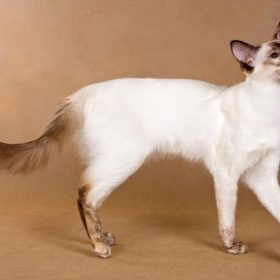 Seychellois Longhair
Seychellois Longhair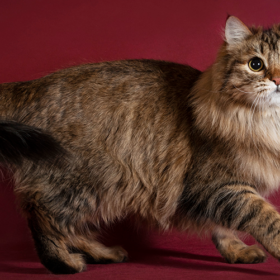 Siberian
Siberian Maine Coon
Maine Coon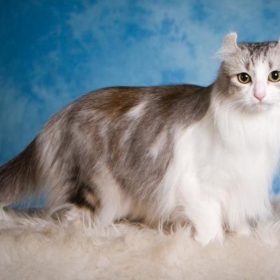 American Curl Longhair
American Curl Longhair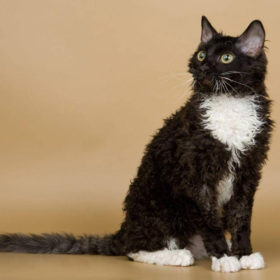 Ural Rex Longhair
Ural Rex Longhair